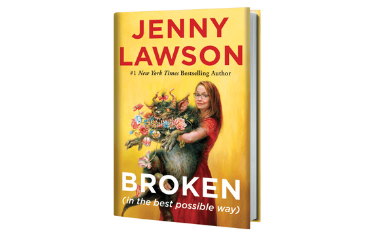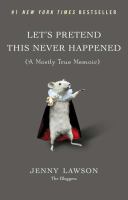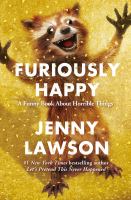Tue, 04/27/2021 - 12:00am

 I’ve been following Jenny Lawson, aka The Bloggess for nearly 10 years, after stumbling across a copy of her first book, Let’s Pretend This Never Happened, at Porter Square Books one day. As soon as I finished reading it (which, fortunately, was at home, because people on the T get very nervous seeing a middle-aged woman hysterically laughing so hard that she’s crying, especially when she’s sitting across from them on the Red Line), I immediately jumped online, first to bookmark Jenny’s blog at thebloggess.com, and secondly to start messaging all of my most twisted friends and raving, “YOU HAVE TO READ THIS BOOK!!! THIS WOMAN IS A #@%$&*! GENIUS!!!”
I’ve been following Jenny Lawson, aka The Bloggess for nearly 10 years, after stumbling across a copy of her first book, Let’s Pretend This Never Happened, at Porter Square Books one day. As soon as I finished reading it (which, fortunately, was at home, because people on the T get very nervous seeing a middle-aged woman hysterically laughing so hard that she’s crying, especially when she’s sitting across from them on the Red Line), I immediately jumped online, first to bookmark Jenny’s blog at thebloggess.com, and secondly to start messaging all of my most twisted friends and raving, “YOU HAVE TO READ THIS BOOK!!! THIS WOMAN IS A #@%$&*! GENIUS!!!”
(A small word of warning: Jenny swears, a lot, so if that kind of thing bothers you, you should probably stop right here, because she’s not the writer for you. For those who don’t mind frequent and enthusiastic profanity, onward!)
 A couple of years later, the followup, Furiously Happy, was released, and Porter Square Books was fortunate enough to be a stop on Jenny’s book tour, so I bought tickets to the reading for myself and my best friend Pauline, so she could come bombing down from upstate NH, and we both could meet our heroine. The store was so packed that there was a line winding out the door and through the parking lot (PSB had put speakers outside so that those who couldn’t get inside could hear), and when the Town Car with Jenny pulled up and she got out, she was greeted with the kind of cheering and screaming that I hadn’t heard since, well, my last Nine Inch Nails show. She looked a bit embarrassed, but also pleased and happy to see that a large contingent of her loyal and extremely enthusiastic following had turned out in force, just to see her.
A couple of years later, the followup, Furiously Happy, was released, and Porter Square Books was fortunate enough to be a stop on Jenny’s book tour, so I bought tickets to the reading for myself and my best friend Pauline, so she could come bombing down from upstate NH, and we both could meet our heroine. The store was so packed that there was a line winding out the door and through the parking lot (PSB had put speakers outside so that those who couldn’t get inside could hear), and when the Town Car with Jenny pulled up and she got out, she was greeted with the kind of cheering and screaming that I hadn’t heard since, well, my last Nine Inch Nails show. She looked a bit embarrassed, but also pleased and happy to see that a large contingent of her loyal and extremely enthusiastic following had turned out in force, just to see her.
You’re probably wondering by now just how a mild-mannered woman from West Texas became a rock-star writer, so let me explain: Jenny is one of the best popular writers today whose work deals extensively with physical (rheumatoid arthritis in particular) and especially mental illness (severe depression, generalized anxiety disorder, ADHD, self-harm) from a first-person perspective, and does so with understanding, intelligence, and seriously black humor--in my humble opinion, and that of many others, really the only way to cope when Life is using a trebuchet to bombard you with an orchard’s worth of lemons. That’s not all, though: you also get tales about her family (Dad the taxidermist, Mom, sister Lisa, long-suffering husband Victor, and daughter Hailey), pets (Dorothy Barker the papillon dog; Ferris Mewler and Hunter S. Thomcat, the two cats; and various taxidermied creatures who also have bad puns for names, as well as Beyonce the giant metal chicken), and aspects of life that most people deal with, but not necessarily with Jenny’s cockeyed perspective. (I don’t happen to know a pharmacist who eats dog biscuits while working the drive-through window, or how to deal with one’s cat eating a puffball-and-jingle-bell-toy, not to mention its later, erm, reappearance, but Jenny does.)
 Why am I explaining all of this? Because Jenny’s latest book, Broken (in the best possible way) has just been released, and while you don’t absolutely have to have this much background to enjoy it, it definitely helps the pieces fall into place if you do. (You should, of course, read the first two books at your earliest opportunity; I’m just giving you some context until you can.) It’s a continuation of her previous topics (illness, family, the weirdness of everyday life), but it also goes deeper, with more brutal honesty seeping through. Let me put it this way: Jenny has always been able to make me laugh, but this time she made me cry as well.
Why am I explaining all of this? Because Jenny’s latest book, Broken (in the best possible way) has just been released, and while you don’t absolutely have to have this much background to enjoy it, it definitely helps the pieces fall into place if you do. (You should, of course, read the first two books at your earliest opportunity; I’m just giving you some context until you can.) It’s a continuation of her previous topics (illness, family, the weirdness of everyday life), but it also goes deeper, with more brutal honesty seeping through. Let me put it this way: Jenny has always been able to make me laugh, but this time she made me cry as well.
From the book’s epigraph (Leonard Cohen’s “Ring the bells that still can ring/Forget your perfect offering/There is a crack in everything/That’s how the light gets in”) onward, the focus in Broken is on breaking, going to pieces, and--sometimes--coming back together, changed but perhaps better for the breaking. Jenny writes about her worries of succumbing to dementia, since she’s already forgetful in her 40s, and later accompanies her mother to visit her grandmother, a dementia patient, in the latter’s “memory facility.” “...[M]y mother tells me that even though it’s a terrible disease it has been strange and wonderful to get a glimpse into the past at what my grandmother was as a child...[A] concentrated version of who she always has been…” She can predict rainy weather due to the aches in her bones. She ends up with tuberculosis, lupus, and pernicious anemia as a result of the medications she needs for her arthritis, and “I am quickly labeled a ‘drug seeker’... because I’m addicted to the sensation of not being in abject pain. I’m weird like that.” ”The Things We Do to Quiet the Monsters,” the longest chapter of the book, goes into detail about the toll treatment-resistant depression takes, how she finally resorts to transcranial magnetic stimulation (TMS) in a last-ditch effort to manage both depression and anxiety, and the tears of joy and relief when she actually goes into remission for a few months, long enough to accompany Hailey to the mall on one Sunday, and later both Hailey and Victor on their European vacation, something she had never been able to do, and which she feared would never be possible.
She writes about her marriage, reminding us that we only see the funny bits she includes in her writing, not the hard work, commitment, and love that it takes to keep a marriage together and more happy than not for nearly 25 years. Victor worries that she may not need him once her depression goes into remission. “An Open Letter to My Health Insurance Company,” which she actually does send to her insurance company after yet another denial of medications she needs to stay alive (they actually did approve the meds after this), ought to go viral--hell, Bernie Sanders needs to make a deal with the publisher to send out copies to anyone who questions the need for Healthcare for All. Finally, in “Sometimes There Is Beauty in Breaking,” Jenny finds herself mourning for a dove figurine that was accidentally broken, despairing that she’ll ever be able to find all of the tiny pieces to repair it, but deciding to keep it anyway. “She has a story to tell. Broken things always do.” Later, Victor suggests using the dove for kintsugi, a Japanese art of repairing broken objects with gold-dusted lacquer so that the brokenness becomes part of the item’s story, and adds to its beauty. “[B]ut I explained that I couldn’t find all the pieces. He shrugged and said, ‘They’re here. They can’t just disappear. We’ll find them eventually.’”
Before you start wondering if the entire book is in that vein, I assure you it’s not--there are plenty of Jenny stories about the silliness inherent in living that might make you blow soda through your nose if you’re drinking while you read. Many truisms make more sense with a bit more added to them: “AIM HIGH...Because your blow dart will lose altitude over the distance to your enemies and you need to account for that.” An entire chapter is devoted to Most Embarrassing Moments submitted on Twitter by fans. There are various warped ideas for products to pitch on Shark Tank. It’s possible to lose shoes while you’re wearing them. Working with editors on a book will drive everyone involved up the wall. She can never go back to the Post Office due to a package sent by a fan. I’d tell you more, but I really don’t want to spoil your fun, and because I’d like to know that I’m not the only person who was side-eyed on the T for cry-laughing while reading “And Then I Bought Condoms for My Dog.” (Not for the usual purposes, you understand, because Dorothy Barker is a girl...oh, just read it, OK?)
Honestly, I can’t give you a stronger recommendation to read this book, especially given how crazy the past year-plus has been. “The world is shattered and we wander barefoot through one another’s broken shards and glittering slivers. And some of us bleed from the cuts. And some of us heal. And if you’re lucky, you do both. We are broken, We are healing. It never ends. And, if you look at it in just the right light, it is beautiful.”
--Robin Moore, Senior Substitute Librarian

Add new comment